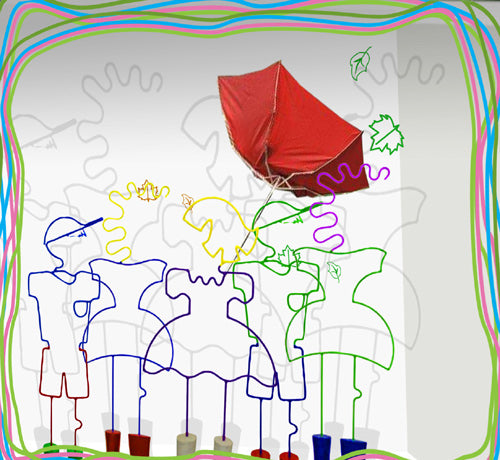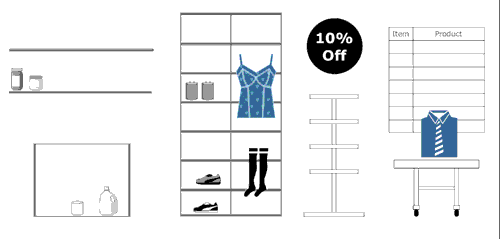Visual merchandising is a marketing practice in which the brand or image from one product or service is used to sell another.
Merchandising itself is selling products that are related to the core business. For example, selling baseball caps at a baseball game is merchandising. Visual merchandising are the ways in which merchandise is sold. Visual merchandising is creating attractive displays and careful placement of visual elements - which can be anything - photos, pictures, sofas, lighting, to increase sales of merchandise.
It is a well known that the human eye is naturally attracted to colours and shapes.
The famous Russian artist Kandinsky created abstract art base on this knowledge using
random lines, colours, and shapes to create attractive art based on what he called "the principle of inner beauty".
Principles of Visual Merchandising
It is a well known psychological phenomenon that the human eye is highly sensitive to the human form. A similar principle applies in visual merchandising. Forms and colours are used to attract customers attention to products placed carefully in a window display or on the shop floor. The human form attracts the attention of people. Use bright lighting and colourful displays to create window displays that attract attention. Use lines and shapes to attract attention. Use shadows for dramatic effects.
Planograms/Floor Plans

A floorplan is called a planogram and is a diagram of fixtures and products that illustrates how and where retail products should be displayed. It is the diagram used for visual merchandising and planning your shop layout and design. It is useful if you own a franchise or have many stores where you want a consistent shop layout. For example, you want customers to have the same experience walking into any of your shops. You can buy software for doing this or use free drawing tools. Planograms form part of a retail businesses visual merchandising strategy. This could be in the form of a document or powerpoint that is used by the visual merchandiser to pitch store layout and design ideas to the owner. This might also include a project plan, timeline and resources needed.
Designing Window Displays
It's a good idea to plan your window display or shop floor layout. A simple sketch can be helpful or a more involved 3D rendering can be made.

Use of Mannequins for Visual Merchandising
The use of mannequins as models in shop windows and retail stores for visual merchandising is a common practice in retail stores. Window designers for clothes shops place mannequins in the window to attract the attention of passers-by. Mannequins are also used inside shops to display clothes and for visual merchandising.This is a well-known retail technique used to increase the sales of fast selling items. People are drawn to mannequins and foot traffic near the areas that mannequins placed will increase.

Placing items that sell easily next to more expensive items have been shown to increase the sales of the less expensive items. If you want shoppers to read a sign such as "10% Discount" - place the sign next to the mannequin for maximum results. Mannequins have their own unique "body language", which conveys information to the potential buyer, for example, an outstretched arm or positioning of the head and eyes at a target product, or an elegant posture all convey subtle and powerful subliminal messages to the customer.
Placing mannequins in stores, salons, and boutiques, and shops is an effective way to attract customers and increase sales. Imagine placing a large statue in the middle of your store. This is sure to attract attention to that area. A mannequin effectively serves the same purpose as an expensive piece of art does in attracting peoples attention. Place the mannequin in close proximity to the stock.
Mannequin full-figures and hands of mannequins attract the attention of passers-by. Placing jewellery - not necessarily on a jewellery hand, but near the hand
elevates the status of the item and increases the chances of the customer seeing the product. Placing mannequin busts in window displays is a profitable technique for jewellery store owners.
Mannequins act as sales assistants - remember that further steps are usually required by the shopkeeper to encourage action. This could be with signage or human sales assistants.
Some Ideas
- Keep things modern and funky
- Mix it up
- Good examples: Harvey Nichols/Selfridges/Liberty window displays
- Your main window is your feature presentation
- Use mannequins in your store
- Mannequins help customers see what clothes look like when worn - it is difficult to see this when clothes are on a hanger
- Mannequins attract peoples attention
- Use emotion in window displays - good example is laughing mannequin by Big Smile Mannequins from Canada
- Use sculptural pieces - parts of cars, trees, antiques, retro, futuristic...
- Very important: Use lighting
- Use fans to blow clothing or hair
- Use lines, reflection, shadows, and contrast (chiaroscuro - google this)
- Use mannequins made from different materials: plastic, wireframe, transparent, moving (motorized), glass
- Use faceless/headless/armless/legless mannequins
- Mannequins parts: heads, arms, hands, legs to display scarves, hats, rings, socks
- Use child mannequins for displaying children's clothing
- Boost sales by selling accessories - promoted by mannequin parts
- Use layers of clothing for winter - e.g. shirt, sweater, and jacket - display as many items of clothing as possible on in-store mannequins
- Use mannequins without clothes
Share your ideas below in the comments.
